The Near East Side is a neighborhood located near downtown Columbus, Ohio, made up of several neighborhoods: Mount Vernon, King-Lincoln Bronzeville, Eastgate, Franklin Park, Nelson Park, Olde Towne East, and Woodland Park.
Columbus, the state capital and Ohio's largest city, has numerous neighborhoods within its city limits. Neighborhood names and boundaries are not officially defined. They may vary or change from time to time due to demographic and economic variables.

The Cass Park Historic District is a historic district in Midtown Detroit, Michigan, consisting of 25 buildings along the streets of Temple, Ledyard, and 2nd, surrounding Cass Park. It was listed on the National Register of Historic Places in 2005 and designated a city of Detroit historic district in 2016.

The East Jefferson Avenue Residential District in Detroit, Michigan, includes the Thematic Resource (TR) in the multiple property submission to the National Register of Historic Places which was approved on October 9, 1985. The structures are single-family and multiple-unit residential buildings with construction dates spanning nearly a century, from 1835 to 1931. The area is located on the lower east side of the city.

Frank L. Packard was a prominent architect in Ohio. Many of his works were under the firm Yost & Packard, a company co-owned by Joseph W. Yost.
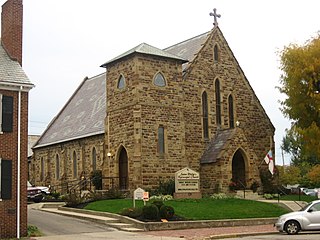
Howell & Thomas was an American architectural partnership formed by Carl Eugene Howell (1879–1930) and James William Thomas, Jr. (1876–1973) in Columbus, Ohio, and later, Cleveland, Ohio, that designed many residences for wealthy clients between 1908 and 1930. The partners were classmates at University of Pennsylvania and first established their practice in Columbus, Ohio. They designed homes for the Euclid Golf subdivision along Fairmont Boulevard in Cleveland Heights, built on the site of John D. Rockefeller's once private course.

The Columbus Foundation is a nonprofit charitable organization in Columbus, Ohio, founded in 1943.
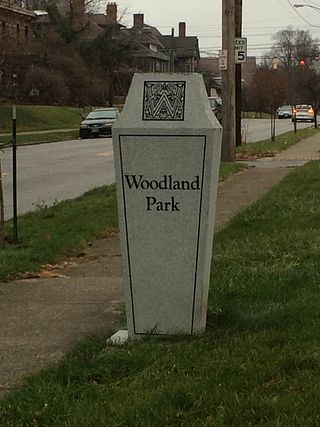
Woodland Park is a residential neighborhood located in the Near East Side of Columbus, Ohio that houses approximately 1,500 residents. The neighborhood was previously home to such figures as artist Emerson Burkhart, cartoonist Billy Ireland, and judge William Brooks. Established in the early 20th century, Woodland Park has grown from its planned neighborhood roots into a modest neighborhood that contains various faith communities, schools, sources of entertainment and recreation, and borders an extension of the Ohio State University medical center.

Richards, McCarty & Bulford was an American architectural firm. The General Services Administration has called the firm the "preeminent" architectural firm of the city of Columbus, Ohio. A number of the firm's works are listed on the National Register of Historic Places. The firm operated until 1943.
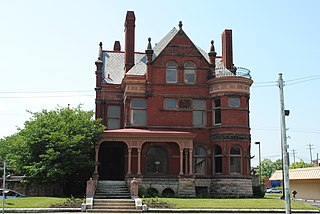
The W. H. Jones Mansion was built in 1889 at 731 East Broad Street, Columbus, Ohio as the residence of dry goods store owner William H. Jones and his wife Josephine. The original cost to build it was $11,250. He lived there until 1923. Jones modelled the house after another mansion in Barnesville, Ohio. The Olde Towne East Neighborhood Association successfully prevented it from being demolished to make way for a Long John Silver's restaurant. The home is an example of Queen Anne style architecture, with a corner turret, third story ballroom and a carriage house in the rear. Its foundation is high ashlar stone, its roof is slate, and the main body of the building is made of red pressed brick.

The Columbus Civic Center is a civic center, a collection of government buildings, museums, and open park space in Downtown Columbus, Ohio. The site is located along the Scioto Mile recreation area and historically was directly on the banks of the Scioto River.
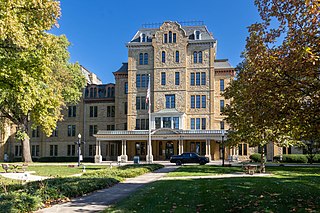
Columbus Public Health is the health department of Columbus, Ohio. The department is accredited by the Public Health Accreditation Board. The department dates to 1833, when the city's mayor appointed five citizens to help with its cholera outbreak. It became a permanent body to activate whenever health emergencies arose.

The East Town Street Historic District is a historic district in Downtown Columbus, Ohio. The site was listed on the National Register of Historic Places in 1976 and the Columbus Register of Historic Properties in 1982; the district boundaries differ between the two entries.
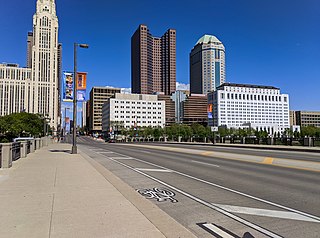
Broad Street is a major thoroughfare in Central Ohio, predominantly in Franklin County and Columbus. It stretches east from West Jefferson at Little Darby Creek to Pataskala. The street is considered one of Columbus's two main roads, along with High Street.

The 18th & E. Broad Historic District is a historic district on Broad Street in the Near East Side of Columbus, Ohio. The district was added to the Columbus Register of Historic Properties in 1988. Its properties were added to the E. Broad St. Multiple Resources Area on the National Register of Historic Places in 1986.

The 21st & E. Broad Historic District is a historic district on Broad Street in the Near East Side of Columbus, Ohio. The district was added to the Columbus Register of Historic Properties in 1988. Its properties were added to the E. Broad St. Multiple Resources Area on the National Register of Historic Places in 1986.

The East Broad Street Commercial Building is a historic building in Columbus, Ohio. It was built in 1930 and listed as part of the E. Broad St. Multiple Resources Area on the National Register of Historic Places in 1986. The building has served numerous businesses, including doctor's offices, insurance agencies, and a Kroger store (1930-1946). Chinese restaurants operated out of the building from 1930 to 1995: Golden Lotus from 1930 to 1950 and Jong Mea from 1950 to 1995.
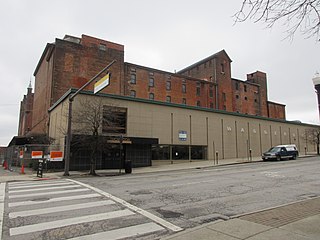
The L. Hoster Brewing Company is set of historic buildings in the Brewery District of Columbus, Ohio. The site was listed on the National Register of Historic Places in 2009.

The C.E. Morris House is a historic house in Columbus, Ohio, United States. The house was built in 1897 and was listed on the National Register of Historic Places in 1986. The C.E. Morris House was built at a time when East Broad Street was a tree-lined avenue featuring the most ornate houses in Columbus; the house reflects the character of the area at the time. The building is also part of the 18th & E. Broad Historic District on the Columbus Register of Historic Properties, added to the register in 1988.

The Joseph F. Firestone House was a historic house at 1266 E. Broad Street in Columbus, Ohio. The building contributed to the East Broad Street Historic District, on the National Register of Historic Places. It was demolished by the Columbus Foundation in 2008.






















